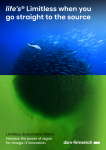EFSA rejects Martek omega-3 infant health claim
The verdict will be a cause of concern for those parties that have submitted omega-3 health claims under the European Union’s nutrition and health claims regulation, as Martek’s dossier was widely regarded as being very strong.
The rejection is EFSA’s eighth of nine claims assessed with only a Unilever-submitted plant sterol/cholesterol lowering claim being approved so far. The Parma, Italy-based risk assessor has more than 2500 claims to assess before a January, 2010 deadline.
Rejected
The NDA stated the claimant failed to demonstrate causality between consumption of docosahexaenoic acid (DHA) and arachidonic acid (ARA) and a benefit to neural and eye development in infants between the ages of six months and three years.
Martek’s article 14 claim submission read: “DHA and ARA support neural development of the brain and eyes.” Article 14 claims relate to disease reduction and children’s claims.
In its verdict, EFSA’s Panel on Dietetic Products, Nutrition and Allergies (NDA), found some of Martek’s data to be“not pertinent to the claim”. This included studies on the effect of long chain polyunsaturated fatty acids on newborn babies.
These were rejected because, while the health benefit was not challenged outright, the study period related only to newborn babies and not infants up to three years old as referenced in the claim’s detail.
These studies were therefore “not representative of the target population”.
Two studies measured the visual maturation of one year olds and the NDA noted that “visual-evoked potential acuity was significantly more mature in the intervention groups compared to controls.”
But it stated a positive correlation “might” be determined only in infants up to “4-6 months of age”, adding:
“The applicant did not present any study investigating the effects of DHA and ARA supplementation starting at six months of age on visual maturation or on any other measure of brain development, e.g., cognitive function, in healthy infants fed unenriched formula during the first six months of life.”
The NDA concluded: “On the basis of the data presented, the Panel concludes that a cause and effect relationship has not been established between the consumption of DHA and ARA starting at six months of age and the neural development of the brain and eyes in infants and young children up to the age of three years.”
In response, a Martek spoksesperson told NutraIngredients.com it was disappointed with the verdict but would pursue a claim relating to visual benefits in infants aged 6-12 months that have been breast fed until the age of 4-6 months.
The NDA said children up to one year-old should consume 80mg of DHA per day and up to 105mg of ARA.
Maryland-based Martek’s version of DHA is an algae-sourced omega-3 that is the global market leader in infant formula. Martek manufactures ARA from a fungal source. The company was unavailable for comment at the time of publication.
Baby milk
The UK-based pro-breast milk group, Baby Milk Action (BMA), welcomed the claim’s rejection.
“This news is extremely welcome,” said BMA policy director, Patti Rundall, OBE. “[It comes] at a time when companies are stepping up their marketing of follow-on formula…including in China.”
In a statement BMA said: “While there is no doubt about the importance of essential fatty acids in infant and young child nutrition, research results remain inconclusive about their efficacy when added to formulas. Moreover, questions remain regarding the safety of the processes and ingredients used.”
DHA naturally occurs in fish, fish oil and algae and the fact Martek’s algae-sourced DHA is vegetarian has contributed to its popularity in infant formula and follow-on milk.
ARA naturally occurs in meat and egg products, and in fungal oil.
To access the opinion click here.











